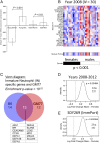Multicenter Systems Analysis of Human Blood Reveals Immature Neutrophils in Males and During Pregnancy
- PMID: 28179497
- PMCID: PMC5337813
- DOI: 10.4049/jimmunol.1601855
Multicenter Systems Analysis of Human Blood Reveals Immature Neutrophils in Males and During Pregnancy
Abstract
Despite clear differences in immune system responses and in the prevalence of autoimmune diseases between males and females, there is little understanding of the processes involved. In this study, we identified a gene signature of immature-like neutrophils, characterized by the overexpression of genes encoding for several granule-containing proteins, which was found at higher levels (up to 3-fold) in young (20-30 y old) but not older (60 to >89 y old) males compared with females. Functional and phenotypic characterization of peripheral blood neutrophils revealed more mature and responsive neutrophils in young females, which also exhibited an elevated capacity in neutrophil extracellular trap formation at baseline and upon microbial or sterile autoimmune stimuli. The expression levels of the immature-like neutrophil signature increased linearly with pregnancy, an immune state of increased susceptibility to certain infections. Using mass cytometry, we also find increased frequencies of immature forms of neutrophils in the blood of women during late pregnancy. Thus, our findings show novel sex differences in innate immunity and identify a common neutrophil signature in males and in pregnant women.
Copyright © 2017 by The American Association of Immunologists, Inc.
Figures



References
-
- Furman D. 2015. Sexual dimorphism in immunity: improving our understanding of vaccine immune responses in men. Expert Rev. Vaccines 14: 461–471. - PubMed
-
- Klein S. L., Flanagan K. L. 2016. Sex differences in immune responses. Nat. Rev. Immunol. 16: 626–638. - PubMed
-
- Engler R. J. M., Nelson M. R., Klote M. M., VanRaden M. J., Huang C.-Y., Cox N. J., Klimov A., Keitel W. A., Nichol K. L., Carr W. W., Treanor J. J., Walter Reed Health Care System Influenza Vaccine Consortium 2008. Half- vs full-dose trivalent inactivated influenza vaccine (2004-2005): age, dose, and sex effects on immune responses. Arch. Intern. Med. 168: 2405–2414. - PubMed

